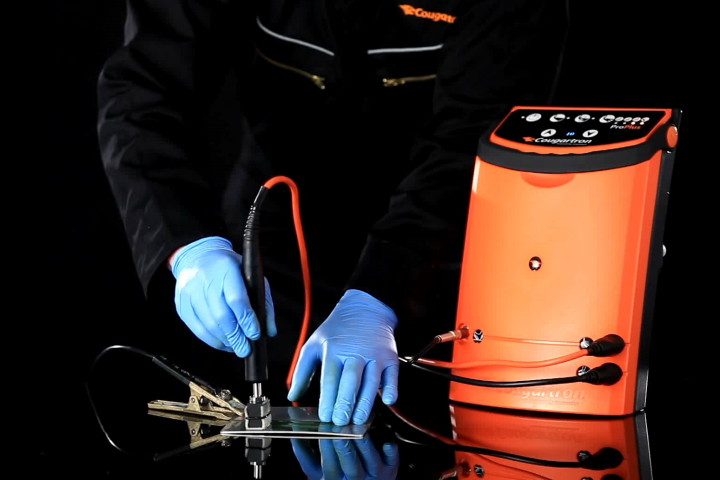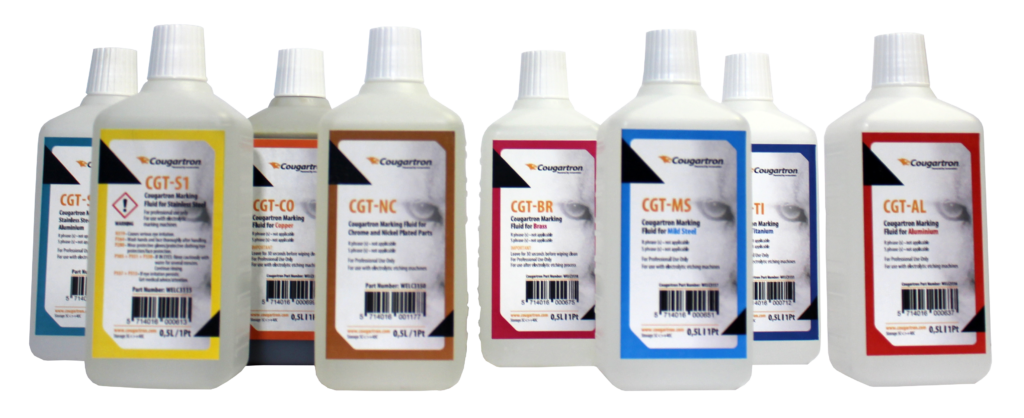Understanding the Role of Etching and Marking Fluids
Marking & Etching | Wednesday, 31 January 2018
The role of electrolytic marking fluids
Marking and etching are common methods used in a variety of industries. The process of creating some manner of branding to track and identify parts or machinery is helpful and often required by law. There are several different types of processes and equipment used for marking and etching, including electrochemical.
Introduction to the process and fluids
Electrochemical marking and etching as the name implies is a process of using both an electrical charge and chemicals. A small electrical charge creates the image in the marking/etching process with the assistance of certain fluids. What are these fluids and what is the importance in the process?
Read more about the electrochemical marking process here.

There are two types of fluids used for marking and etching: an electrolyte solution and a neutralizer.
The electrolyte marking fluid usually is a water-based solution. It contains soluble substances that when dissolved give positive and negative ions, called cations and anions respectively. These substances include acids, base, and salts. The amount of electrolytes in the solution determines its strength and ability to conduct electricity.
This is important because all metals have a varying degree of conductivity and require different levels of electrolytes.
The purpose of using the electrolyte fluid is to assist in the flow of the (low-voltage) electric charge from the electrode head of the etching or marking machine.
The abundance of ions in the electrolyte solution is attracted to the electrons from the electrode head. In other words, apply the electrolyte fluid on the cleaned metal surface, followed by a stencil of the image/ logo you want on the metal. Then, using the electrode head of the marking machine, follow the image design. The electrical charge caused by the reaction of the electrode head and electrolyte fluid creates a permanent image or etching on the object.
The importance of neutralizing
There is another fluid used in the etching/marking process once the image is on the metal. It may be tempting to wipe the mark with a clean rag and perhaps a cleaner thinking that is enough. Do not do this. Marking and etching of metal parts may solve the problem of tracking or identifying parts. Unfortunately, improper cleaning after the process can lead to another problem—corrosion.
The process of etching and marking creates a change to the surface of a metal. Marking places an imprint on the metal’s surface while etching actually penetrates and removes surface material. Both actions cause a change in the metal.
The process of imprinting a dark image on the metal’s surface or removing the surface layer by etching leaves behind contaminants. Some contaminants are visible while others are not.
The mark or etching may look all right after wiping. Unfortunately, wiping alone will not always remove the residue left from creating the image. This residue contains acids, and salts from the electrolyte solution. The residue is not harmful to the person applying it but increases the possibility of corrosion if left on the metal. Removing the residue is easy when using a neutralizing fluid.
The neutralizing fluid does as the name implies. It neutralizes the harmful acids and salts left behind after applying the mark or etching. Neutralizing fluid restores the pH balance on the metal surface, removing contaminants that could affect both the new image and the metal.

Electrochemical marking and etching is an excellent method to mark, track, and identify parts. It offers a combination of low-cost, high resolution, and permanent results on conductive metals of varying thickness. Using the correct electrolyte and neutralizing fluids for the application makes the process of marking or etching metal fast and easy.
Cougartron offers a wide selection of marking fluids for various types of metal surfaces – stainless steel, aluminum, mild steel, copper, zinc, brass, and even titanium.

Popular marking fluids from Cougartron
Loading products...
Please wait while the products load.


 English
English  English (US)
English (US)  German
German  Danish
Danish  Swedish
Swedish  French
French  Polish
Polish  Spanish
Spanish